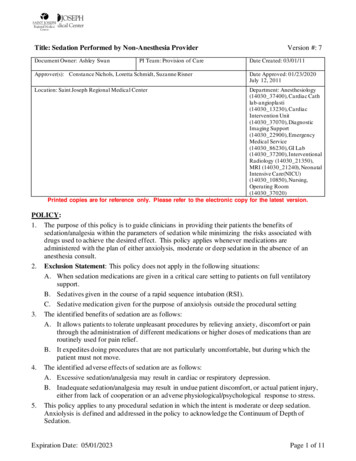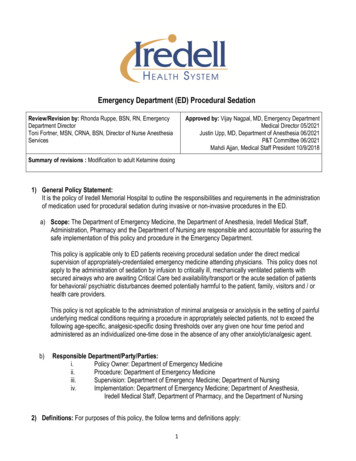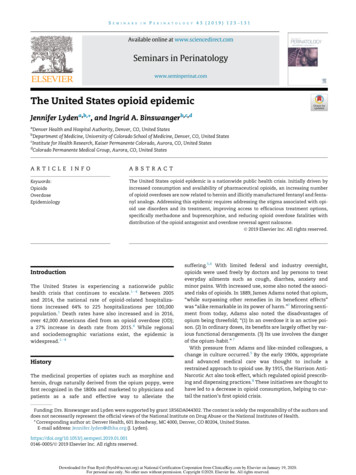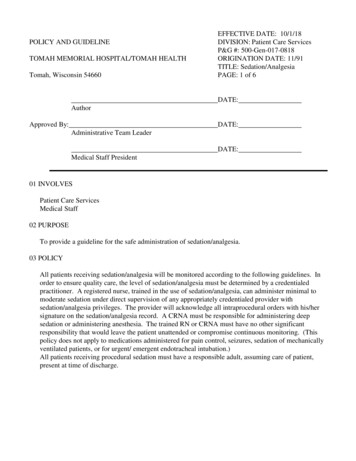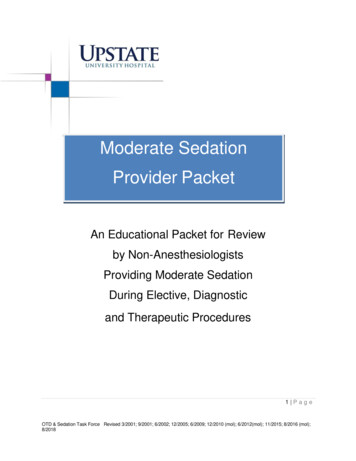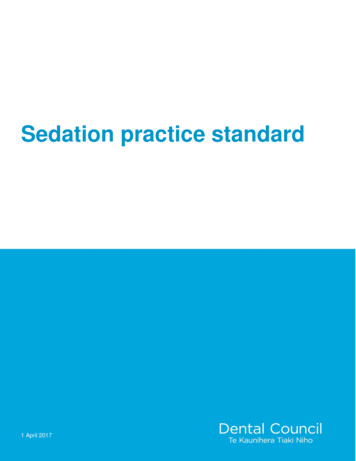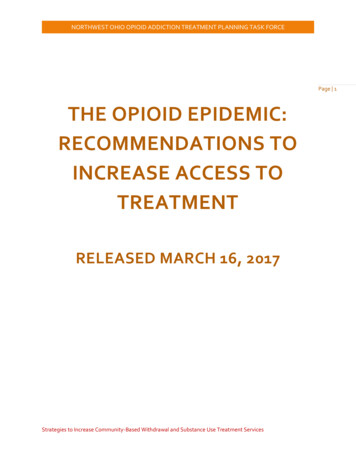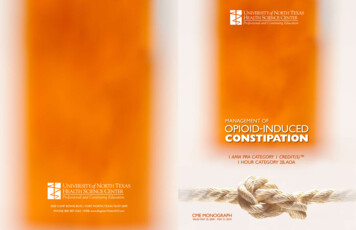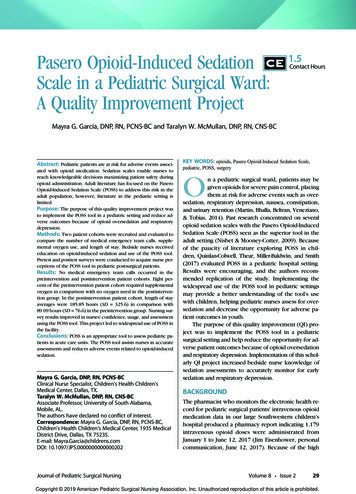
Transcription
Pasero Opioid-Induced SedationScale in a Pediatric Surgical Ward:A Quality Improvement ProjectContact HoursMayra G. Garcia, DNP, RN, PCNS-BC and Taralyn W. McMullan, DNP, RN, CNS-BCAbstract: Pediatric patients are at risk for adverse events associated with opioid medication. Sedation scales enable nurses toreach knowledgeable decisions maximizing patient safety duringopioid administration. Adult literature has focused on the PaseroOpioid-Induced Sedation Scale (POSS) to address this risk in theadult population; however, literature in the pediatric setting islimited.Purpose: The purpose of this quality improvement project wasto implement the POSS tool in a pediatric setting and reduce adverse outcomes because of opioid oversedation and respiratorydepression.Methods: Two patient cohorts were recruited and evaluated tocompare the number of medical emergency team calls, supplemental oxygen use, and length of stay. Bedside nurses receivededucation on opioid-induced sedation and use of the POSS tool.Pretest and posttest surveys were conducted to acquire nurse perceptions of the POSS tool in pediatric postsurgical patients.Results: No medical emergency team calls occurred in thepreintervention and postintervention patient cohorts. Eight percent of the preintervention patient cohort required supplementaloxygen in comparison with no oxygen need in the postintervention group. In the postintervention patient cohort, length of stayaverages were 185.85 hours (SD 325.6) in comparison with89.09 hours (SD 76.6) in the preintervention group. Nursing survey results improved in nurses' confidence, usage, and assessmentusing the POSS tool. This project led to widespread use of POSS inthe facility.Conclusions: POSS is an appropriate tool to assess pediatric patients in acute care units. The POSS tool assists nurses in accurateassessments and reduces adverse events related to opioid-inducedsedation.Mayra G. Garcia, DNP, RN, PCNS-BCClinical Nurse Specialist, Children's Health Children'sMedical Center, Dallas, TX.Taralyn W. McMullan, DNP, RN, CNS-BCAssociate Professor, University of South Alabama,Mobile, AL.The authors have declared no conflict of interest.Correspondence: Mayra G. Garcia, DNP, RN, PCNS-BC,Children's Health Children's Medical Center, 1935 MedicalDistrict Drive, Dallas, TX 75235.E-mail: Mayra.Garcia@childrens.comDOI: 10.1097/JPS.0000000000000202Journal of Pediatric Surgical NursingKEY WORDS: opioids, Pasero Opioid-Induced Sedation Scale,pediatric, POSS, surgeryOn a pediatric surgical ward, patients may begiven opioids for severe pain control, placingthem at risk for adverse events such as oversedation, respiratory depression, nausea, constipation,and urinary retention (Martin, Bhalla, Beltran, Veneziano,& Tobias, 2014). Past research concentrated on severalopioid sedation scales with the Pasero Opioid-InducedSedation Scale (POSS) seen as the superior tool in theadult setting (Nisbet & Mooney-Cotter, 2009). Becauseof the paucity of literature exploring POSS in children, Quinlan-Colwell, Thear, Miller-Baldwin, and Smith(2017) evaluated POSS in a pediatric hospital setting.Results were encouraging, and the authors recommended replication of the study. Implementing thewidespread use of the POSS tool in pediatric settingsmay provide a better understanding of the tool's usewith children, helping pediatric nurses assess for oversedation and decrease the opportunity for adverse patient outcomes in youth.The purpose of this quality improvement (QI) project was to implement the POSS tool in a pediatricsurgical setting and help reduce the opportunity for adverse patient outcomes because of opioid oversedationand respiratory depression. Implementation of this scholarly QI project increased bedside nurse knowledge ofsedation assessments to accurately monitor for earlysedation and respiratory depression.BACKGROUNDThe pharmacist who monitors the electronic health record for pediatric surgical patients' intravenous opioidmedication data in our large Southwestern children'shospital produced a pharmacy report indicating 1,179intravenous opioid doses were administrated fromJanuary 1 to June 12, 2017 (Jim Eisenhower, personalcommunication, June 12, 2017). Because of the highVolume 8 Issue 229Copyright 2019 American Pediatric Surgical Nursing Association, Inc. Unauthorized reproduction of this article is prohibited.
volume of opioids administered on the data report, theprimary investigator was prompted to evaluate patientsafety practices concerning opioid administration onthe pediatric surgical unit.Clinical assessment of oversedation and signs of respiratory depression prompt nursing staff to call themedical emergency team (MET), which is synonymouswith a rapid response team at this institution (Jungquist,Smith, Nicely, & Polomano, 2017). The MET consists ofa team of providers that immediately assess the patientat the bedside to treat and prevent complications suchas cardiac arrest, conditions necessitating transfer toan intensive care unit, or death (Jones, DeVita, &Bellomo, 2011). If a patient is found to have respiratorydepression, the code team is called (Reed, 2013). Although each institution may differ slightly in averagerange for respiratory rates and thus respiratory depression, baseline respiratory assessment rates for pediatrics(breaths per minute) are as follows: infants, 25–55;toddlers/preschoolers, 65–110; school-age, 14–22; andadolescents, 12–18 (Ward & Hisley, 2009). Ranges outside the normal parameters may signal respiratory depression, prompting the nurse to initiate interventions andescalate concerns with the primary healthcare provider.At our institution in 2015, six MET calls occurred onthe pediatric surgical unit; five incidences were because of respiratory distress related to oversedation after transfer from the postanesthesia care unit (PACU).Use of the POSS can decrease the use of the additionalhospital resources such as the MET team or the Codeteam because nurses are constantly monitoring for levelof sedation and implementing directed interventionsfrom POSS (Kobelt, Burke, & Renker, 2014).In 2015, clinical nurse specialists interviewed nursing staff on the pediatric surgical unit regarding thenurses' opinion on the frequency and cause of unitalarms to address the problem of alarm fatigue, a JointCommission's (2014) patient safety goal. Nurses identified the frequent respiratory rate alarm when patientsreturn from the PACU. The frequency of respiratoryalarms provides qualitative and quantitative data onnursing staff concerns of respiratory depression in thepostsurgical pediatric population. This data was important to this QI project because the increased rate ofalarms on the pediatric surgical unit was often seen aspatients were transferred from the PACU. Nursesoften disregarded the alarms or did not recognize alarmwarnings as a sign of early opioid-induced sedation.One of the goals of this QI project was to educate nurseson opioid-induced sedation, recognition, and when tointervene. Use of the POSS tool can assist nurses in identifying when patients are excessively sedated afterJournal of Pediatric Surgical Nursingsurgery and showing early and late signs of respiratorydepression (Pasero, 2013).A thorough bedside nursing assessment facilitatesthe early identification of complications from opioidmedication use, such as opioid-induced sedation. To reduce the risk of opioid-induced sedation, a completenursing assessment is performed paying particular attention to respiratory rhythm, rate, and depth as wellas sedation level (Cooper, Stannard, & Noble, 2015;Drebert, 2014; Jarzyna et al., 2011; Pasero, 2012). Theliterature also supports the use of technological monitoring such pulse oximetry or end-tidal carbon monoxide monitoring in conjunction with a thorough nursingassessment (Carlisle, 2014; Jarzyna et al., 2011; Pasero,2012). Before any opioid pain medication administration, the literature also supports nurse assessments ofsedation risk and providing early patient/family educationon postsurgical sedation risks (Pasero, 2013; Veney, 2013).QI recommendations include use of a standardizedpain tool along with hospital policies that include sedation monitoring guidelines (Vermaire et al., 2011). A literature search was conducted in the CINAHL databaseusing the search term “Pasero Opioid-Induced SedationScale.” Any literature published more than 5 years agoor not applicable to this QI project was excluded fromthe literature review. The literature review did not produce high-level research articles pertaining to the use ofthe POSS tool, with only one article related to the use ofthe POSS tool in pediatric patient populations found(Quinlan-Colwell et al., 2017). Whereas other toolswere evaluated for implementation, the POSS tool isthe only assessment that measures sedation before andafter an opioid has been administered in conjunctionwith pain. Other tools, such as the Comfort Scale,provide a readiness score for mechanically ventilatedpatients; the Ramsay Scale and Richmond AgitationSedation Scale are used with the Aldrete scoring toolto assess sedation before, during, and after a sedativeis given (Hoover, 2018). The POSS, with a reliabilityCronbach alpha of .903 in adults, identifies patientswith increased sedation levels with early recognitionof respiratory depression (Cooper et al., 2015; Daviset al., 2017; Drebert, 2014; Kobelt, Burke, & Renker,2014). All applicable literature was appraised usingthe John Hopkins Nursing Evidence-Based Practice Research Evidence Appraisal tool and the John HopkinsNursing Evidence-Based Practice Non-Research Evidence Appraisal tool (Dang & Dearholt, 2017).In 2013, the American Society of Pain ManagementNursing conducted a survey of its members to identifypractices related to opioid-induced sedation. Fifty-threepercent of the survey respondents reported utilizingVolume 8 Issue 230Copyright 2019 American Pediatric Surgical Nursing Association, Inc. Unauthorized reproduction of this article is prohibited.
the POSS tool within their institution in adult patients(Jungquist, Willens, Dunwoody, Klingman, & Polomano,2014). Nurses report that the POSS tool is easy to understand and provides clear directions based on the patientassessment score (Drebert, 2014). The POSS tool allowsthe nurse to grade the patient's arousability and verbalcommunication with follow-up interventions in comparison with our hospital's previous assessment, which solelyassessed sedation (Davis et al., 2017; Smith, Farrington, &Matthews, 2014). Recommendations to increase patientsafety with patients treated on patient-controlled analgesiaincluded use of standardized pain and sedation scales(Martin et al., 2014).METHODSQI ModelThis QI project used the Plan, Do, Study, Act (PDSA)model as a foundation to improve the quality in bedsidenurse assessment of opioid sedation in pediatric patients.Using the steps of the model, the first phase, “plan,”assessed the current situation and analyzed potentialcauses (Cleary, 2015) determining that a specific toolto monitor for opioid oversedation in postsurgical pediatric patients within the current system was lacking. Inaddition, nurses were not familiar with the POSS tool orany opioid oversedation tools. The “do” step of thePDSA model, the implementation of the POSS to reduceadverse patient outcomes from opioid oversedation,was tested in a 24-bed inpatient surgical unit at a largemetropolitan pediatric hospital. During the “study”step of the model, results were evaluated to determinewhether the tool identifies patients at risk of opioidoversedation and reduces the risk of respiratory deterioration or failure (see Figure 1). The final step, “act” ofthe PDSA model, identifies actions to standardize improvements and plan for continuous improvement(Cleary, 2015). With the results from this project indicating an improvement in sedation assessment practices and a decreased risk of opioid oversedation inpediatric postsurgical patients, the tool became a partof the policies and procedures of all patients in ourpediatric facility. Institution-wide nursing education ofthe POSS tool is ongoing and a standard componentof routine in-services and competencies. House-wideadoption of the POSS tool is fully implemented in theemergency room, inpatient units, and ambulatory areas.SubjectsThis QI project evaluated two separate subjectgroups: nurses and patients. Patients were further defined as preintervention and postintervention cohorts.Journal of Pediatric Surgical NursingPresurveys and postsurveys completed by the nursingstaff encompassed the nursing group.PatientsPreintervention patient cohort included a chartreview to obtain data to evaluate current practices regarding pain and sedation assessment. Twenty-five prospective preintervention patient charts were assessed.The postintervention patient cohort represented a convenience sample of eligible patients who met theinclusion criteria and where a POSS assessment wascompleted; 20 postintervention QI project patient participants agreed to participate.Patient Inclusion CriteriaInclusion criteria for chart review of patients andpostintervention patient cohort included1. prospective pediatric patient receiving opioids foranalgesic purposes; and2. postoperative pediatric patients.Patient Exclusion CriteriaExclusion criteria for chart review and postintervention patient cohorts included1. primary diagnosis of respiratory distress or headinjury; and2. admission to the trauma service.Nursing Inclusion CriteriaAll nursing staff on the 24-bed inpatient surgical unitwere given a pretest and posttest survey to evaluatePOSS tool in the pediatric postsurgical setting. The sample size of nursing staff participants was dependent onthe number of completed surveys.SettingThe setting for this QI project was on a 24-bed inpatient surgical unit at a large metropolitan pediatric hospital. This inpatient surgical unit additionally housestrauma patients and overflow from different services.On the basis of the patient exclusion criteria, trauma patients were excluded because of the complexity of injuries but could benefit from this tool in the future.Ethical ConsiderationsThis project was reviewed by the institutional review board and deemed a QI project and exempt. ThisQI project was also approved by the quality and safetydepartment within the hospital.Interventions and Data CollectionA mandatory education session or in-service wasprovided to all nurses on the surgical unit during theirVolume 8 Issue 231Copyright 2019 American Pediatric Surgical Nursing Association, Inc. Unauthorized reproduction of this article is prohibited.
FIGURE 1. Plan, Do, Study, Act cycle of quality improvement project.monthly education outlining the project process, assessing patients using the POSS, opioid safety, and opioidmedication peak times. A graphic containing medication onset, peak, and duration times for commonly usedopioids was placed in the medication room and nurses'station. Five in-service opportunities were providedand part of nursing's mandatory education requirements. Thirty nurses attended the in-service with a91% attendance rate. Bedside nurses were providedwith a pretest survey via a SurveyMonkey link in theirwork email. After completion of the nursing staffeducational in-services, enrollment of the postintervention patient cohort began. The clinical nursespecialist (project manager) for the unit collecteddata from the nursing staff who completed the POSSassessment. Preintervention chart reviews occurred duringJournal of Pediatric Surgical Nursingthe same time as the postintervention patient enrollment period. Patients were enrolled in the postintervention patient cohort during a 12-week period. At theend of the 12-week period, the posttest survey was administered to the nursing staff via a SurveyMonkey linkin their work email.MeasuresIn the preintervention patient cohort, de-identifieddata were extracted from the electronic medical recordand entered into a password-protected Excel document.Data obtained included gender, age, diagnosis, opioidmedication administered with dose, pain score, pain assessment tool, level of alertness before and after opioidmedication administration, use of oxygen, and sedationassessment during the first 24 hours of receiving theVolume 8 Issue 232Copyright 2019 American Pediatric Surgical Nursing Association, Inc. Unauthorized reproduction of this article is prohibited.
opioid. Respiratory rate, pulse oximetry readings, andrespiratory assessments were obtained before and aftereach opioid dose. Any data on held opioid medicationdoses, decreases or increases in dose, length of stay(LOS), and escalations to providers or MET team werealso extracted. For the postintervention patient cohort,the same data from the preintervention group were extracted in addition to the documented POSS score.For the nursing staff, data were collected from thepretest and posttest surveys (Figure 2). The nursing staffsurvey was adapted from a study exploring the use ofthe POSS tool in pediatric critical care and inpatient unitFIGURE 2. Nursing pretest and posttest survey results.Journal of Pediatric Surgical NursingVolume 8 Issue 233Copyright 2019 American Pediatric Surgical Nursing Association, Inc. Unauthorized reproduction of this article is prohibited.
setting (Quinlan-Colwell et al., 2017). The nursing survey was placed into SurveyMonkey, filled out electronically by the nursing staff, and returned to the projectmanager for collection and analysis.AnalysisAll de-identified data collected from the preintervention and postintervention patient cohorts wereentered into a password-protected Microsoft Excel file.Survey results from the nursing staff pretests and posttestswere downloaded as an Excel file from SurveyMonkey.Descriptive statistics and actuarial analyses were conducted using IBM SPSS software.The number of MET calls, supplemental oxygenuse, and LOS were data points used to compare the effectiveness of the POSS tool in the two patient cohortgroups. The pretest and posttest survey results provided data on the nurse staff perceptions of the POSStool in this QI project. The overall project success wasevaluated based on the data obtained from the patientcohort groups as well as the nursing staff survey results.RESULTSPatientsPopulationTwenty-seven families of pediatric patients wereapproached and provided information about the QIproject in the preintervention group. Two families declined, with 25 agreeing to participate. Of the 25 patients,60% (n 15) were male, whereas 40% (n 10) were female. Zero percent of the patients were newborn, 4%(n 1) were infants, 8% (n 2) were toddlers, 16%(n 4) were preschoolers, 48% (n 12) were schoolaged children, and 24% (n 6) were adolescents. Thepreintervention patient cohort common diagnoses aredisplayed in Table 1. Other diagnoses ranged from hernias, other surgical procedures, and feeding difficulties.Twenty patients were approached about participation in the QI project in the postintervention group,with all agreeing to participate. Of the 20 patients,65% (n 13) were male, whereas 35% (n 7) werefemale. Zero percent of the patients were newborn,10% (n 2) were infants, 0% were toddlers, 10%(n 2) were preschoolers, 40% (n 8) were schoolaged children, and 40% (n 8) were adolescents. Thepostintervention patient cohort common diagnosesare displayed in Table 1. Other diagnoses ranged fromother surgical procedures to feeding difficulties.Pain AssessmentIn the preintervention patient cohort, there were262 pain assessments completed before opioid painJournal of Pediatric Surgical Nursingmedication and within 1 hour of administration. Nursingstaff used a 0–5 numeric scale in 52% (n 15) of the patients, a 0–5 Wong-Baker Faces Scale in 24% (n 6) ofthe patients, and the Face, Legs, Activity, Cry, Consolabilityscale in 24% (n 6) of the preintervention patient group(Merkel, Voepel-Lewis, Shayevitz, & Malviya, 1997; WongBaker FACES Foundation, 2016). In the postinterventionpatient cohort, 74 pain assessments were completedbefore the patient received opioid medication andwere reassessed within 1 hour. Nursing staff used a0–5 numeric scale in 70% (n 14) of the patients, a0–5 Wong-Baker Faces Scale in 20% (n 4) of the patients, and the Face, Legs, Activity, Cry, Consolabilityscale in 10% (n 2) of the postintervention patientgroup.Pain MedicationsIn the preintervention patient cohort, 102 doses ofopioids were administered. Eighty-two percent (n 84)of the doses were morphine, 11% (n 11) werehydromorphone, and 7% (n 7) of the doses were fentanyl in this patient group. The postintervention patientcohort had 36 doses of opioids administered. Sixtyseven percent (n 24) of the doses administered weremorphine, 33% (n 12) were hydromorphone, and nopatients were given fentanyl in the postinterventiongroup. No differences were noted between groups forage, diagnosis, pain tool used, and doses given.MET Calls, LOS, and Supplemental Oxygen UseThere were no MET calls for either the preintervention and postintervention patient cohorts duringthe project implementation. Eight percent (n 2) ofthe preintervention prospective patient cohort requiredsupplemental oxygen in comparison with the zero percent in the postintervention QI group. LOS averages inhours was 89.09 (SD 76.6) in the preintervention patient group in comparison with 185.85 (SD 325.6) inthe postintervention patient cohort.Escalation to Healthcare ProviderEscalation was needed when nurses identified achange in status, vital signs, intake or output requiringan intervention, or provider order. In the preinterventiongroup, 68% (n 17) of the patients did not require anyescalation to the healthcare provider. Sixteen percent(n 4) of the patients showed signs of decreased urineoutput or urinary retention, 8% (n 2) showed hypertension, 8% (n 2) showed tachycardia, 8% (n 2)showed signs of respiratory depression requiring oxygen therapy, and 4% (n 1) showed signs of a rash thatwere escalated to the healthcare provider. OrderedVolume 8 Issue 234Copyright 2019 American Pediatric Surgical Nursing Association, Inc. Unauthorized reproduction of this article is prohibited.
Table 1: Comparison of Preintervention andPostintervention Patient GroupsPreinterventionCohort(N 25)PostinterventionCohort(N 20)Male60% (n 15)65% (n 13)Female40% (n 10)35% (n 7)Newborn0% (n 0)0% (n 0)Infant (1–12 months)4% (n 1)10% (n 2)GenderAge groupToddler (1–3 years)8% (n 2)0% (n 0)Preschooler(3–5 years)16% (n 4)10% (n 2)School age(6–12 years)48% (n 12)40% (n 8)Adolescents(13 years)24% (n 6)40% (n 8)DiagnosisAppendicitis24% (n 6)20% (n 4)Orthopedic36% (n 9)20% (n 4)Urinary4% (n 1)10% (n 2)Abscess4% (n 1)10% (n 2)Mass8% (n 2)0% (n 0)24% (n 6)40% (n 8)aOtheraOther diagnoses include hernia repair, sleeve gastrectomy, obstruction,feeding difficulty, and respiratory conditions.interventions included supplemental oxygen (8%,n 2) and intravenous fluids (12%, n 2).In the postintervention group, 85% (n 17) of thepatients did not require any escalation to the healthcareprovider. For the remaining 15% of the patients, escalation occurred for one exhibiting signs and symptoms ofhypotension and decreased urine output, one patientshowed hypertension, and another showed bradycardia.Only one patient required additional interventions ofintravenous fluids (5%).POSS AssessmentsIn the postintervention group, nursing staff completed 69 POSS assessments. Of these assessments, bedside nurses rated the patient as “1 awake and alert”74% (n 51) of the time. In 14% (n 10) of the assessments, nurses described the patients as “S sleep, easyto arouse” and 12% (n 8) as “2 slightly drowsy, easilyaroused” as designated on the POSS tool (Table 2).Journal of Pediatric Surgical NursingNursingParticipantsNine registered nurses filled out a 10-question pretest after attending a POSS in-service on the unit butbefore using the POSS tool. At the time of the in-service,a sedation scale was not utilized within the institution.Nurses completed the survey (pretest) before usingthe POSS with a patient and after (posttest). Five POSSin-services were provided for nursing staff. In the pretest, 33% of the participants (n 3) reported between2 and 5 years of experience, 33% (n 3) reported between 5 and 10 years of experience, and 33% (n 3) reported more than 10 years of experience in nursing. Inthe posttest survey, six nurses filled out the survey,with four saying they also filled out the pretest. Fiftypercent (n 3) of the posttest nurses reported 2–5 yearsof experience, 17% (n 1) reported 5–10 years ofexperience, and 33% (n 2) reported more than10 years of nursing experience.Survey ResultsNursing staff were surveyed using a 10-questionpretest (n 9) and posttest (n 6) to evaluate their perceptions of using the POSS tool in a pediatric surgicalunit (Figure 2). A paired t test compared the means ofsurvey questions. Improvements were found in nurses'confidence that they used the POSS correctly (t(5) 6.325,p .001), using the POSS to score pediatric patientswas easy (t(5) 5.000, p .004), and the POSS wasan appropriate scale to use in pediatric patients (t(5) 3.873, p .012). Improvement between the pretest and posttest survey scores was also identified withthe POSS assisting nursing with continuity of sedationassessments (t(5) 5.000, p .004) and standardizing safe use of opioids when administered for pain(t(5) 5.000, p .004). Pretest and posttest surveys found no significant difference in responses whennurses stated that every patient on opioids for analgesicpurposes should be scored by POSS (t(5) 1.536,p .185). Two questions addressing the POSS assistingnurses in responding appropriately to patient clinicalchanges and nurses feeling confident they scored thepatient's sedation level correctly using the POSS couldnot be computed with a paired t test because the standard error of the difference was 0. A sign test was thenconducted to determine whether there was differencebetween the pretest and posttest surveys for the aforementioned questions. Results of the analysis determinedthat there was an improvement in the nurses feeling confident they scored the patient's sedation level correctlyusing the POSS (p .031) and the POSS assisting nursesVolume 8 Issue 235Copyright 2019 American Pediatric Surgical Nursing Association, Inc. Unauthorized reproduction of this article is prohibited.
Table 2: Pasero Opioid-Induced Sedation ScaleaS Sleep, easy to arouseAcceptable; no action necessary; may increase opioid dose if needed1 Awake and alertAcceptable; no action necessary; may increase opioid dose if needed2 Slightly drowsy, easily arousedAcceptable; no action necessary; may increase opioid dose if needed3 Frequently drowsy, arousable, drifts off to sleep during conversationUnacceptable; monitor respiratory status and sedation level closely until sedation level is stable at less than 3 and respiratory status is satisfactory; decreaseopioid dose 25% to 50%b or notify primaryc or anesthesia provider for orders; consider administering a nonsedating, opioid-sparing nonopioid, such asacetaminophen or an NSAID, if not contraindicated; ask patient to take deep breaths every 15–30 minutes.4 Somnolent, minimal or no response to verbal and physical stimulation; unacceptable; stop opioid; consider administering naloxoned,e; stay with patient,stimulate, and support respiration as indicated by patient status; call Rapid Response Team (Code Blue) if indicated; notify primaryc or anesthesia provider;monitor respiratory status and sedation level closely until sedation level is stable at less than 3 and respiratory status is satisfactory.1994, Pasero C. Used with permission. As cited in Pasero and McCaffery (2011).Appropriate action is given in italics at each level of sedation.bIf opioid analgesic orders or hospital protocols do not include the expectation that the opioid dose will be decreased if a patient is excessively sedated,such orders should be promptly obtained.cFor example, the physician, nurse practitioner, advanced practice nurse, or physician assistant responsible for the pain management prescription.dFor adults experiencing respiratory depression, give intravenous naloxone very slowly while observing patient response (“titrate to effect”). If sedationand respiratory depression occur during administration of transdermal fentanyl, remove the patch; if naloxone is necessary, treatment will be needed fora prolonged period, and the typical approach involves a naloxone infusion. Patient must be monitored closely for at least 24 hours after discontinuationof the transdermal fentanyl.eHospital protocols should include the expectation that a nurse will administer naloxone to any patient suspected of having life-threatening opioidinduced sedation and respiratory depression.ain responding appropriately to patient clinical changes(p .031).DISCUSSIONThis QI project evaluated two separate subject groups todetermine the effectiveness of the POSS tool in assessingpediatric opioid-induced sedation in postsurgical patients.One of the data points used to compare the effectiveness of the tool was the number of MET calls.Comparison of the preintervention and postintervention patient groups showed no differences in thepatient cohorts when comparing the number of METcalls as there were MET calls during implementation ofthis QI project.Another data point used to compare the effectiveness of the POSS tool was the use of supplemental oxygentherapy in the preintervention and postintervention patient cohorts. The preintervention patient cohort had alow percentage of patients who required supplementaloxygen use. These patients were found to require supplemental oxygen postoperatively once they arrived
the John Hopkins Nursing Evidence-Based Practice Re-search Evidence Appraisal tool and the John Hopkins Nursing Evidence-Based Practice Non-Research Evi-dence Appraisal tool (Dang & Dearholt, 2017). In 2013, the American Society ofPainManagement Nursing conducted a survey of its members to identify practices related to opioid-induced sedation.
